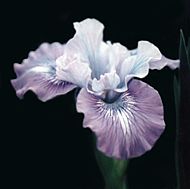Almanac Article
Rebloom In PCI
John Weiler, Rialto Gardens, Fresno, California
Almanac, Fall 2000 Vol.29, No.1: 9-10
[Adapted and slightly modified for the web]
In the spring issue of the Almanac, Garry Knipe described his search for fragrance and rebloom in Pacific Coast Iris hybrids. This was a pleasant surprise, since I had already begun to write notes on my observations of rebloom for named clones of these irises in my own garden. Although I cannot add information about fragrance, I can contribute a bit to the rebloom interest.
Most reblooming iris show "cycle rebloom" - flowering in the normal season, and then again in the autumn. Less common is "repeat rebloom", with a second flowering closely following the normal spring bloom.
In the past I noticed occasional out-of-season stalks on some of our PCIs in the warm Central Valley at Fresno, but I had not recorded which iris rebloomed or when it occurred. This year I carried a notebook every time I worked in the garden and was surprised to find how many cultivars actually rebloomed.
In Fresno, spring bloom usually takes place from mid-March to the end of the first week or ten days in April. Rebloom was seen only on well established plants - two to four year old clumps. None occurred on first year plants. These PCIs clearly fit into the "repeat rebloom" pattern.
Three weeks after spring bloom, the first to repeat bloom was the violet on white plicata, WISHING (Ghio 93). It produced a single rebloom stalk on a large clump, but I remembered it had rebloomed in one earlier year.
At 4 weeks, both POINT SANTA CRUZ (Ghio 95), a pretty, warm terra cotta self and GORDOLA (Ghio 96), a broad, deep yellow, bloomed again. POINT SANTA CRUZ had one repeat stalk, but GORDOLA produced four on a single clump.
At 5 weeks, three other cultivars began blooming. BABY BLANKET (Ghio- 98), a rich brownish red overlaid with pearly mauve at the signal gave one stalk as did VENTANA (Ghio 86), a white with gold signal and lavender eyelash markings around the signal. CHIEF SEQUOIA (Weiler 91), a lavender blue self, has consistently produced rebloom on some plants each year since its introduction.

I keep a dozen plants, and usually about one in four reblooms each year. This year four rebloomed, with one starting 5 weeks after spring bloom, two at 6 weeks and the last at 7 weeks. Three had two rebloom stalks and the other produced three.
The early spring stalks were either unbranched with three buds in the terminal, or had one branch with a total of three or four blooms. In contrast, the rebloom stalks all had two branches plus terminal and a total of 6-7 flowers per stem, effectively extending the rebloom time.
CHIEF SEQUOIA is the only one of these PCIs reported to rebloom earlier in The Checklist of Reblooming Iris, with several records from California and one from Portland, Oregon, all in USDA zones 8 and 9. In my garden, the plicata, WISHING, has rebloomed in two different growing seasons, so it too can be recommended as one to try.
The others reblooming this year may never rebloom again, but some or all may well prove to have a tendency to rebloom. I will watch them carefully for the next few seasons. In the meantime, any of these varieties are certainly worth a try in your garden.
I have never seen a PCI with fall blooms, although I tried to grow the autumn remontant, LADY AUTUMN (Bernard 96). It did not become established, and have I been able to find the plant again for a second try. It would seem desirable breed it with the late spring or early summer repeat rebloomers, hoping to get multiple bursts of bloom during the growing season. It may be possible to get spring, repeat, and autumn bloom on a single clone.
In the years since introducing CHIEF SEQUOIA, I have worked to retain the broader, taller foliage and high bud count inherent in the line from the strong influence of Iris munzii, even though there was little to suggest remontancy could be obtained.
Some descendents of a sibling to CHIEF SEQUOIA rebloomed during the past three years. A couple are medium blue violet with plicata-patterned falls and yellow signal, another is a self, much more blue with less violet influence, triangular falls and no signal. A large clump of this latter produced nine rebloom stalks 6 weeks after spring bloom ended.
Two more recent seedlings have very broad, nearly orbicular falls and both have the plicata pattern. One is a pale lavender blue on white and the other is a little darker with far less lavender influence. Each produced one repeat bloom stalk 5 weeks after their spring bloom.
I intercrossed these seedlings this spring, to see if the rebloom trait could be enhanced. I plan to introduce WISHING into the line and make some crosses to broaden the color range in these remontants. Clones like GORDOLA for yellow, BABY BLANKET and POINT SANTA CRUZ should help produce the red-brown tones and VENTANA may help us obtain white.
Crosses may have to be carried several generations to recover the remontant trait in significant numbers. I understand that at the Monterey Bay Iris Show a seedling of Joe Ghio's was exhibited which is a rebloomer. Excitement? Of course!
This is the dawn of a remontant group of PCIs. You can help by reporting any rebloom in your garden. Try a few crosses to enhance remontancy. The more people working on the problem, the sooner we will enjoy much extended bloom and repeated rebloom in our PCIs.